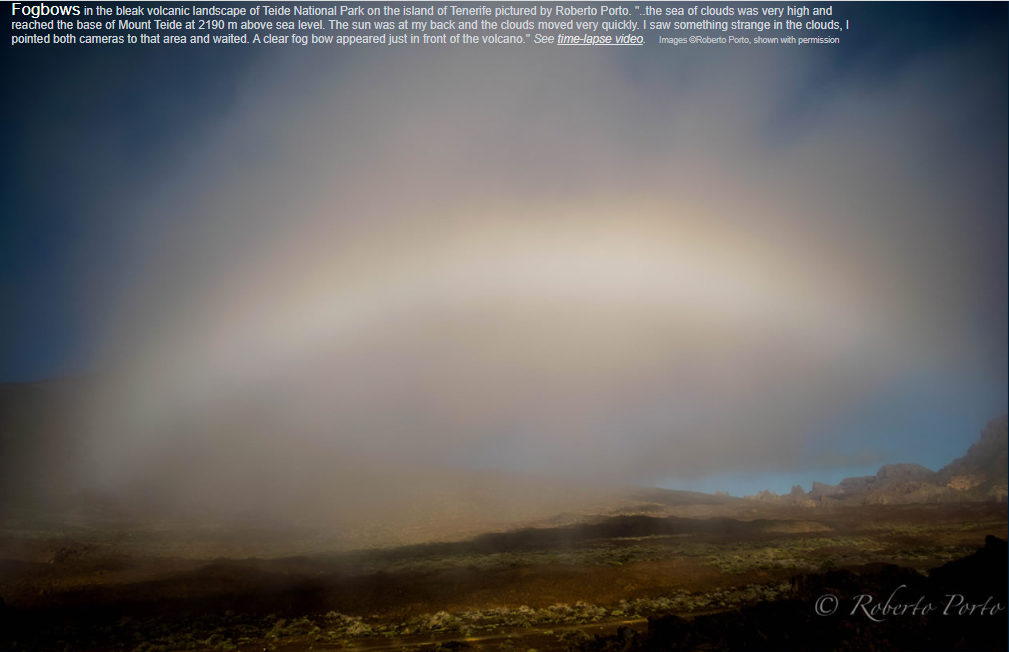Mount Teide, Tenerife Fogbows - OPOD
Mount Teide, Tenerife Fogbows - A Phenomenon in the Volcanic Landscape
Mount Teide, located in Teide National Park on the mesmerizing island of Tenerife, is not only a towering volcanic peak but also a captivating site for witnessing atmospheric optical phenomena. One such phenomenon that occasionally graces the bleak volcanic landscape is the elusive fogbow. These ethereal displays of light, captured by photographer Roberto Porto, offer a captivating glimpse into the interplay between clouds, sunlight, and the unique topography of Mount Teide.
The Enchanting Appearance of Fogbows
Fogbows, also known as white rainbows or cloudbows, are formed under specific atmospheric conditions. Similar to rainbows, fogbows are created by the interaction of sunlight with water droplets in the air. However, unlike rainbows that form in rain showers, fogbows emerge when light encounters tiny water droplets suspended in fog or mist. The droplets in fog are typically smaller than raindrops, resulting in a different optical phenomenon.
The Perfect Setting at Mount Teide
The volcanic terrain surrounding Mount Teide provides an ideal backdrop for the formation of fogbows. As moist air rises from the lower altitudes and encounters the colder temperatures at higher elevations, it condenses into fog or mist. When these fog banks reach the base of Mount Teide, they create a mystical sea of clouds that can extend up to 2,190 meters above sea level. This unique atmospheric condition sets the stage for the enchanting appearance of fogbows.
A Photographer's Serendipitous Encounter
Roberto Porto, an astute observer and talented photographer, found himself in the right place at the right time to capture the captivating fogbows near Mount Teide. While gazing at the sea of clouds from a vantage point with the sun behind him, Porto noticed something peculiar amidst the swiftly moving clouds. Intrigued, he swiftly aimed both of his cameras at the area and patiently awaited the unfolding spectacle. To his delight, a distinct and luminous fogbow materialized right before the majestic silhouette of Mount Teide.
The Ephemeral Beauty of Fogbows
Fogbows exhibit a unique ethereal beauty, characterized by their pale, almost white, appearance. Unlike rainbows with their vibrant array of colors, fogbows typically lack the intense hues due to the smaller droplet size in fog. The diffraction and interference of sunlight within these minuscule droplets lead to a diffused and fainter color spectrum. The resulting fogbow often manifests as a ghostly arc of light with a softer and less pronounced coloration.
Understanding the Science behind Fogbows
The science behind fogbows lies in the intricate interplay between light and water droplets. When sunlight encounters these tiny droplets, it undergoes diffraction, where the light waves bend and spread out. This diffraction process causes the light to disperse, resulting in the circular shape of fogbows. Furthermore, as the light waves pass through the droplets, they undergo interference, leading to a reduction in the intensity of specific colors. The combination of diffraction and interference gives rise to the characteristic pale and diffuse appearance of fogbows.
Capturing Fogbows on Camera
Photographing fogbows can be a challenging endeavor due to their subtle nature and diffuse colors. However, with the right conditions and techniques, it is possible to capture their ephemeral beauty. To photograph a fogbow effectively, it is essential to have a strong backlight source, such as the sun, positioned behind you. This positioning allows for optimal illumination and contrast between the fogbow and its surroundings. Additionally, using a polarizing filter can help enhance the visibility of the fogbow by reducing glare and increasing color saturation.
In conclusion, the fogbows that grace the volcanic landscape of Mount Teide in Tenerife offer a captivating display of nature's artistry. These elusive optical phenomena, formed by the interaction of sunlight with tiny water droplets suspended in fog, create ethereal arcs of light against the backdrop of the majestic volcano. Roberto Porto's fortuitous encounter and skillful photography have allowed us to witness the mesmerizing beauty of fogbows, reminding us of the awe-inspiring wonders that exist within our atmosphere. So, the next time you find yourself near Mount Teide on a misty day, keep your eyes peeled for the enchanting allure of a fogbow dancing amidst the clouds.

Fogbows in the bleak volcanic landscape of Teide National Park on the island of Tenerife pictured by Roberto Porto. "..the sea of clouds was very high and reached the base of Mount Teide at 2190 m above sea level. The sun was at my back and the clouds moved very quickly. I saw something strange in the clouds, I pointed both cameras to that area and waited. A clear fog bow appeared just in front of the volcano." See time-lapse video. Images ©Roberto Porto, shown with permission

Note: this article has been automatically converted from the old site and may not appear as intended. You can find the original article here.
Reference Atmospheric Optics
If you use any of the definitions, information, or data presented on Atmospheric Optics, please copy the link or reference below to properly credit us as the reference source. Thank you!
-
<a href="https://atoptics.co.uk/blog/mount-teide-tenerife-fogbows-opod/">Mount Teide, Tenerife Fogbows - OPOD</a>
-
"Mount Teide, Tenerife Fogbows - OPOD". Atmospheric Optics. Accessed on November 26, 2024. https://atoptics.co.uk/blog/mount-teide-tenerife-fogbows-opod/.
-
"Mount Teide, Tenerife Fogbows - OPOD". Atmospheric Optics, https://atoptics.co.uk/blog/mount-teide-tenerife-fogbows-opod/. Accessed 26 November, 2024
-
Mount Teide, Tenerife Fogbows - OPOD. Atmospheric Optics. Retrieved from https://atoptics.co.uk/blog/mount-teide-tenerife-fogbows-opod/.